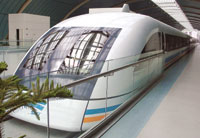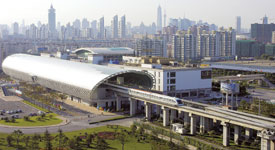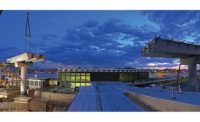 |
| ARRIVED China is first to build commercial maglev trains; U.S. engineers want to emulate. |
Chinas bold move to build 30 kilometers of magnetically levitated high-speed guideway between Shanghai and its new Pudong Airport in three years has resulted in a system of trains moving up to 431 km per hour. It is being hailed as a success, but with engineering challenges that U.S. proponents are taking to heart.
Chinese officials took the giant step to build the worlds first commercial application of the technology after a 2000 visit to Transrapid Internationals test track in Bremen, Germany. Shanghai Maglev Transportation Development Co. Ltd. (SMTDC) was formed to lead the effort to build all structures within three years. The estimated $1.2-billion project included two stations and fabrication of some 2,551 girders, most 24 meters long and weighing 175 tons.
|
Key to the effort was the fast production of specialized machines that fabricated precast concrete girders and fitted their edges with milled steel flanges. The maglev systems stator packs, which contain the electromagnetic cables that propel the trains, are attached to the brackets. Every 1 m of guideway carries 14 m of cable. Continuous steel box beams comprise eight sets of switches.
Neumarkt, Germany-based Max Boegl developed a single hybrid steel-and-concrete beam for installation at the German maglev test facility in 1999. "We got a call that the Chinese decided on a hybrid beam," says Ludwig M. Schoell, vice president for Max Boegl USA Inc., Roswell, Ga. "We flew to China to negotiate a transfer of technology to them."
That occurred in November 2000, and by April 2001 the first fabricating machines were headed to a new 1.1-milelong manufacturing shop in Shanghai.
Project officials say the learning curve was challenging. For example, Chinese batch plants had to improve their mixes to meet the 8,000-psi requirements for the beams, says Schoell. Engineers also avoided fabrication of 350-ton double-length beams first specified for two 40-m river crossings. Instead, Chinese engineers used a 6-m-long steel girder to bridge the distance between two standard length concrete sections, says Lin Guo Bin, special assistant to the SMTDC general manager. Engineers also designed adjustable support bearings to accommodate soft soils along the site.
 |
In a recent presentation at a Transportation Research Board session in Washington, D.C., Wu Xiang-Ming, SMTDC project chief, said other key challenges included temperature-based deformations and concrete creep. "The existing technology needs improvement and optimization," he said. "The propulsion needs newer components of power."
Shanghai officials say German maglev technology is still under consideration for a high-speed rail line linking Shanghai to Beijingas is steel-on-wheel high-speed rail technology. The former "would need modifications if it were to be extended to Beijing," said Wu. "Weve handed documents to Transrapid, and they are improving those issues." Japanese maglev technology is still being developed and is apparently not in the running.
J. Christopher Brady, president of Transrapid-USA, Washington, D.C., says "we are pooling resources with possible universities to look at new types of guideway." He adds that computer simulation to address thermal issues will be needed. Transrapid is involved in several U.S. maglev attempts, including Baltimore, Pittsburgh, Las Vegas-to-Anaheim and Chattanooga-to-Atlanta.
Schoell says his firm also is learning from the Shanghai job and is working on guideway improvements. "Our precast concrete beams can be milled to a precise shape and then our steel attachments are cut by lasers to extremely fine tolerances to achieve the necessarily tight specifications," he says. Walter Antlauf, Max Boegl general manager of TRI Guideways, says the Shanghai job has already led to new Chinese contracts.
 |
| SPEEDING TRAIN Train propelled by magnets through one of Shanghai's two stations. |
U.S. engineers are working on their own types of girders. Karl Frank, director of the maglev guideway research center at the University of Texas, Austin, is working with the California-Nevada High Speed Rail Commission and Hirschfeld Steel Co. Inc., San Angelo, Texas, on versions such as a 150-ft hybrid span with flared bottom flanges. He says the hybrid would weigh less than the German spans and have fewer temperature and load deflections.
For the Anaheim-to-Las Vegas route, currently in preliminary engineering, "a light and flexible steel superstructure is the ideal solution for shear deformations," Frank says. He has been testing a 31-m trapezoidal steel box girder, 2 m deep, that would accommodate seismic displacement. With 3,300 lb of fabricated steel for 1 mile of guideway, "this is a tremendous opportunity for the steel bridge community," he says.
In a trip last fall to Shanghai, U.S. delegates took the eight-minute ride. "The biggest lesson learned," says Arnold Kupferman, maglev program manager for the Federal Railroad Administration, "is that we really ought to have one."


Post a comment to this article
Report Abusive Comment